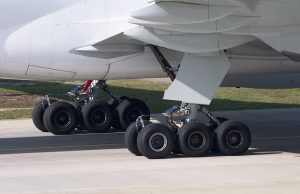
Airplanes rely on landing gear to take off and land. Consisting of wheels connected to a hinge-like system, they are found below the nose and around the wings.
The wheels, of course, are typically retractable. Prior to landing, pilots will lower the airplane’s landing gear. After taking off, on the other hand, they’ll raise the airplane’s landing gear.
If you’ve ever watched an airplane’s landing gear, though, you may recall the nose retracting forward. There are dozens of different setups for landing gear. Nonetheless, the nose landing gear will often retract forward, whereas the rear landing gear around the wings will often retract backward. Why does the nose landing gear retract forward exactly?
Weighs Less Than Rear Landing Gear
The nose landing gear typically weighs less than the rear landing gear. There are usually fewer, as well as potentially smaller, wheels below the nose of an airplane than around the wings. Therefore, the nose landing gear weighs less than the rear landing gear.
Because it weighs so much less, the nose landing gear may fail to retract backward. It will be exposed to the wind. Commercial airplanes can fly at speeds of up to 600 miles per hour. As wind strikes the landing gear, it may prevent it from retracting properly — assuming it features a backward-retracting design.
Using forward-retracting landing gear for the nose solves this problem. The wind won’t create resistance. Rather, a forward-retracting design means that the wind will help to lower the landing gear.
Acts as a Failsafe
With a forward-retracting design, the nose landing gear isn’t reliant on hydraulic pressure. Both the front and rear landing gear use hydraulic pressure to retract. They are connected to a hinge-like system that’s powered by pressurized gas or air. Hydraulic systems such as this can fail, however. Even if the nose landing gear loses hydraulic pressure, pilots can lower it if it features a forward-retracting design.
Forward-retracting landing gear leverage gravity, as well as the wind, to assist in retraction. If there’s a problem with the hydraulics system, pilots can lower forward-retracting landing gear manually. The wind will essentially force the otherwise stuck landing gear to retract.
In Conclusion
Airplanes have different types of landing gear. The nose landing gear will typically retract forward, whereas the rear landing gear around the wings will retract backward. The nose landing gear uses a forward-retracting design because it weighs less than the rear landing gear, and because it acts as a failsafe in the event of hydraulic pressure loss.



